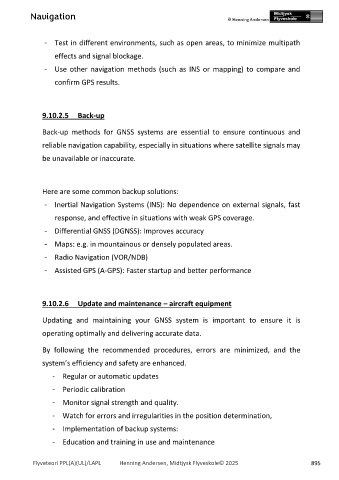Page 895 - PPL-engelsk 2025
P. 895
Navigation
- Test in different environments, such as open areas, to minimize multipath
effects and signal blockage.
- Use other navigation methods (such as INS or mapping) to compare and
confirm GPS results.
9.10.2.5 Back-up
Back-up methods for GNSS systems are essential to ensure continuous and
reliable navigation capability, especially in situations where satellite signals may
be unavailable or inaccurate.
Here are some common backup solutions:
- Inertial Navigation Systems (INS): No dependence on external signals, fast
response, and effective in situations with weak GPS coverage.
- Differential GNSS (DGNSS): Improves accuracy
- Maps: e.g. in mountainous or densely populated areas.
- Radio Navigation (VOR/NDB)
- Assisted GPS (A-GPS): Faster startup and better performance
9.10.2.6 Update and maintenance – aircraft equipment
Updating and maintaining your GNSS system is important to ensure it is
operating optimally and delivering accurate data.
By following the recommended procedures, errors are minimized, and the
system’s efficiency and safety are enhanced.
- Regular or automatic updates
- Periodic calibration
- Monitor signal strength and quality.
- Watch for errors and irregularities in the position determination,
- Implementation of backup systems:
- Education and training in use and maintenance
Flyveteori PPL(A)(UL)/LAPL Henning Andersen, Midtjysk Flyveskole© 2025 895

